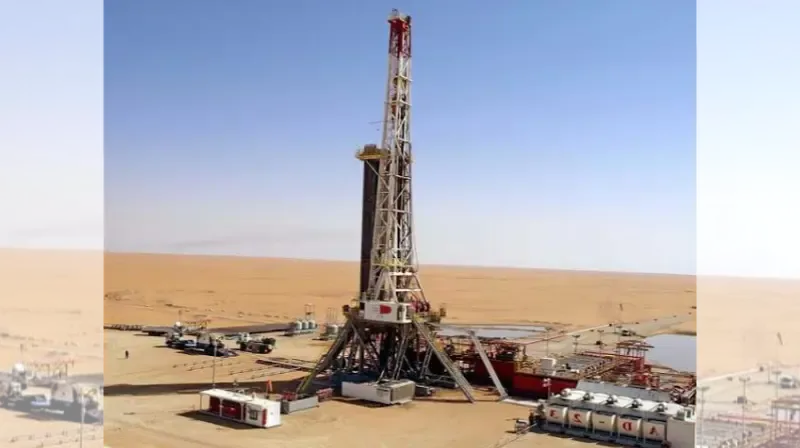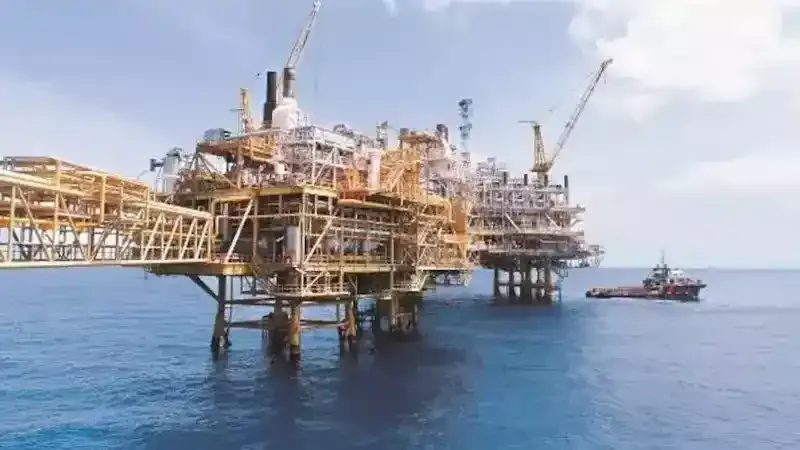Exploring Oil & Gas: Onshore vs. Offshore
Oil and gas production typically involves two methods: Onshore and Offshore.
To put it briefly, onshore operations involve activities conducted on land or near the coastline, whereas offshore activities encompass operations carried out in offshore waters or deep sea.
These two approaches vary in terms of complexity, benefits, and challenges associated with extracting hydrocarbons from underground or seabed reservoirs.
Let's delve deeper into the intricacies of onshore and offshore oil and gas production, outlining the process, benefits, and the significant role it plays in meeting the increasing global energy demand.
Get to Know Onshore and Offshore
Generally, oil and gas production is categorized into two based on location: onshore, which occurs on land, and offshore, which takes place in offshore waters.
1. Onshore: Oil and Gas Production
 |
| Onshore activities (Arabian Drilling - arabdrill.com) |
In the context of the oil and gas industry, "Onshore" refers to exploration, drilling, and production activities conducted on land or in areas closer to the coast. Here are further details:
- Exploration: The process of searching for potential oil and gas reservoirs begins with onshore exploration activities. Techniques such as geological and geophysical surveys are used to identify subsurface structures indicating the likelihood of hydrocarbon presence.
- Drilling: After identifying potential reservoirs, drilling activities take place using drilling rigs on land. These rigs can be conventional land rigs or portable rigs that can be moved between drilling locations. READ: Unlocking the stages of oil well drilling.
- Production: Upon successful drilling and discovery of a reservoir containing oil or gas, production involves extracting hydrocarbons from the reservoir. Onshore production includes production wells located on land, and the extracted resources can be transported through pipelines or land-based transportation systems.
- Infrastructure: Infrastructure for onshore production is generally easier to develop and manage compared to offshore projects. This includes processing, refining, and storage facilities located on land.
The primary advantages of onshore production include better accessibility, generally lower operational costs, and ease of infrastructure development and maintenance. However, potential drawbacks may include limited resource potential compared to offshore projects.
2. Offshore: Oil and Gas Production
(Image: offshore activities)
In the context of the oil and gas industry, "Offshore" refers to exploration, drilling, and production activities conducted in offshore waters or areas far from the coastline. Here is a detailed explanation:
- Exploration: Offshore exploration activities commence with the search for potential oil and gas reservoirs on the seabed. This involves the use of technologies such as 3D seismic surveys and subsea mapping systems to identify geological structures that may contain hydrocarbons.
- Drilling: After identifying potential reservoirs, drilling activities take place using offshore drilling rigs. These rigs can be fixed structures such as offshore platforms or floating rigs that are either semi-submersible or drillships.
- Production: Offshore production involves extracting hydrocarbons from reservoirs on the seabed. Production wells are situated beneath the sea surface, and the extracted hydrocarbons are transported to production facilities located above the sea surface, such as production platforms or floating facilities.
- Infrastructure: Offshore infrastructure involves the construction and maintenance of complex facilities, including production platforms, subsea pipeline systems, and floating or floating production, storage, and offloading (FPSO) units.
The primary advantages of offshore production include the potential for larger resource reserves, diversification of production locations, and significant contributions to the global energy supply. However, offshore projects also entail technical challenges and larger investments compared to onshore projects.
Exploring the Differences Between Onshore and Offshore Operations
The following is a comparison of the complexities of onshore and offshore oil and gas production, providing an overview of the process, benefits, and the crucial role of oil and gas production in the energy sector.
1. Exploration and Drilling
In terms of "exploration and drilling," the comparison between Onshore and Offshore involves significant differences in the processes of exploring and drilling in both locations.
Onshore:
- Exploration: On land, exploration begins with geological and geophysical surveys to identify the potential oil and gas reservoirs. This investigation is more easily conducted on land due to its better accessibility.
- Drilling: Onshore drilling processes tend to be simpler due to the more stable environmental conditions. Drilling is done from the surface of the land to the reservoir below.
Offshore:
- Exploration: Offshore exploration requires more advanced technology, including the use of seismic survey vessels and marine mapping technology to determine potential reservoir locations on the seabed.
- Drilling: Offshore drilling involves offshore platforms or floating rigs. Dynamic sea conditions and varying water depths can increase the complexity of drilling operations.
Some key differences involve higher technical and logistical complexity in the offshore environment. While exploration and drilling onshore may be more easily accessible, the dynamic sea environment and weather conditions offshore add challenges and costs in the offshore sector.
2. Production Systems
In terms of production systems, the differences between Onshore and Offshore can be observed in how oil and gas are extracted, processed, and transported from reservoirs to processing facilities. Here is a key comparison:
Onshore:
- Production System: On onshore production, the production installations are generally simpler. Oil and gas wells are directly connected to processing facilities located on land.
- Infrastructure: Additional infrastructure such as pipelines and land transport networks can be used to deliver oil and gas to processing facilities or terminals.
Offshore:
- Production System: Offshore production involves offshore platforms or floating facilities. These systems are often more complex, including processing facilities above water and subsea infrastructure to connect production wells to processing facilities.
- Infrastructure: Subsea pipelines are often used to transport oil and gas from offshore wells to processing facilities or to shore-based terminals.
These differences reflect the higher technical and logistical challenges in managing oil and gas production in the dynamic and deep-sea offshore environment. Offshore production systems require more advanced technology and equipment, as well as careful logistical planning compared to the more conventional onshore production systems. READ: Facilities and processes of oil and gas production.
3. Environmental Considerations
In terms of environmental considerations, the differences between Onshore and Offshore encompass distinct environmental impacts during oil and gas exploration, drilling, and production. Here is a key comparison:
Onshore:
- Environmental Impact: Onshore production tends to have more localized environmental impacts. These activities can affect terrestrial ecosystems, including soil and surface water.
- Potential Pollution: The risk of soil and surface water pollution is typically higher in onshore production areas, requiring specific measures to manage waste and chemicals.
Offshore:
- Environmental Impact: Offshore production can have broader and more complex environmental impacts, involving influences on deep-sea ecosystems, including marine flora and fauna.
- Potential Pollution: The risk of marine pollution and impacts on marine life is a primary concern. Incidents such as offshore oil spills have significant consequences for the marine and coastal environment.
Both production methods face challenges in minimizing their environmental impacts. However, risk management and environmentally friendly practices continue to be developed to mitigate negative effects on the surrounding environment.
4. Technological Advancements
In terms of technological advancements, the comparison between Onshore and Offshore involves the evolution of technology used in oil and gas exploration, drilling, and production activities. Here is a key comparison:
Onshore:
- Exploration Technology: In onshore production, seismic survey and geophysical technologies are used to map the geological structures beneath the surface.
- Drilling: Onshore drilling processes involve the use of land rigs, which are generally more stable and predominantly terrestrial.
Offshore:
- Exploration Technology: Offshore exploration makes use of advanced technologies such as 3D seismic surveys, subsea mapping, and high-level data processing techniques to obtain more accurate and detailed insights into underwater structures.
- Drilling: Offshore drilling involves the use of offshore rigs, often equipped with dynamic technologies, such as dynamically positioned drilling stations, to handle deep and turbulent waters.
This comparison reflects the need for more sophisticated technology in offshore operations, which are often more complex and require higher precision in identifying underwater resources. Innovations such as the use of robotics, drones, advanced sensors, and automated data processing systems continue to be developed to enhance efficiency and safety in offshore exploration and production.
5. Economic Impact and Global Energy Supply
In terms of economic impact and the global energy supply, the comparison between Onshore and Offshore involves their influence on the world economy and energy supply. Here is a key comparison:
Onshore:
- Local Economic Impact: Onshore production can have a more direct impact on the local economy, including job creation and contributions to the regional economy.
- Stable Energy Supply: Onshore production is often more stable and can provide a sustainable contribution to regional energy supply.
Offshore:
- Large Investments: Offshore projects involve larger investments but can also significantly contribute to the economy through offshore infrastructure development and maintenance.
- Global Energy Supply: Offshore production has the potential to make a substantial contribution to the global energy supply, especially as offshore reservoirs can have significant production volumes.
Both production methods have economic impacts and play significant roles in the global energy supply. Onshore production directly impacts the local economy, while offshore production can make a crucial contribution to the global energy supply, albeit with larger investments. The choice between the two often involves considerations of sustainability, global energy needs, and broader economic factors.
6. Advantages
In terms of advantages, the comparison between Onshore and Offshore involves the positive aspects of both oil and gas production methods. Here is a key comparison in terms of advantages:
Onshore:
- Accessibility and Cost: Onshore production is generally more easily accessible, with operational costs often lower due to facilities being located on land.
- Infrastructure: Onshore infrastructure is usually easier to develop and manage.
Offshore:
- Greater Resource Potential: Offshore projects can have greater resource potential because underwater reservoirs tend to be larger.
- Location Diversification: Enables production in locations far from the coast and land areas with significant resource potential.
Both production methods have their respective advantages. Onshore production is more easily accessible and cost-effective, while offshore production can provide greater resource potential and location diversification. The choice between the two is often influenced by geological conditions, economic factors, and operational sustainability. READ: Oil well types and their function.
Conclusion
In conclusion, the distinction between onshore and offshore oil and gas production encompasses several significant differences. Onshore production, characterized by easier accessibility, relatively lower costs, and direct local economic impact, provides stable operations and readily developed infrastructure. On the other hand, offshore production involves substantial investments but offers the potential for larger resource reservoirs and significant contributions to the global energy supply.
READ: Tracing the history of oil and gas - from ancient flames to future challenges
The advantages of onshore production lie in its operational stability, positive local economic impacts, and the relatively straightforward development of infrastructure. Meanwhile, offshore production presents the opportunity for larger resource potentials, significant global contributions, and the capability to explore locations far from the coast.
The choice between the two often hinges on geological conditions, economic considerations, and operational sustainability. While onshore production provides stability and local benefits, offshore production plays a vital role in meeting global energy needs, albeit with greater technical challenges and investments. Overall, both onshore and offshore production are integral components of the oil and gas industry, complementing each other to meet diverse global energy demands.
Oil and gas production, onshore and offshore, hydrocarbon extraction, onshore operations, offshore activities, energy industry, reservoir exploration, drilling techniques, environmental considerations, technological advancements, reservoir monitoring, subsea production systems, deep-sea environments, offshore exploration.

